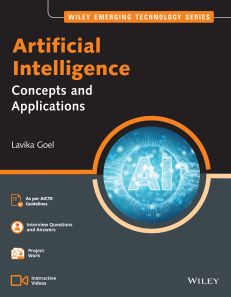Artificial Intelligence: Concepts and Applications
ISBN: 9788126519934
780 pages
Publication Year: 2021
For more information write to us at: acadmktg@wiley.com

Description
Artificial Intelligence: Concepts and Applications is a comprehensive discourse on the fundamental principles and concepts that lead to building artificially intelligent programs. It details the wide range of possible application areas where artificial intelligence can be used. The concepts of heuristic search and development of meta-heuristic algorithms has led a far way towards the development of computational intelligence algorithms and nature inspired algorithms that have been used in a variety of problem solving methods.
Preface
Acknowledgments
About the Author
List of Video Content
PART I Foundations of Artificial Intelligence
Chapter 1 Basics of Artificial Intelligence
1.1 What is Artificial Intelligence?
1.2 Definition of Artificial Intelligence Through Problems
1.3 History of Artificial Intelligence
1.4 Artificial Intelligence – Problems and Techniques
1.5 Production Systems
1.6 Shift in Focus of AI Towards Providing Smarter Solutions
Chapter 2 Problem Solving Methods in Artificial Intelligence
2.1 Introduction
2.2 State Space Search
2.3 Production System
2.4 Problem Characteristics
2.5 Control Strategy
2.6 Issues in the Design of Search Programs
2.7 Search Strategies
2.8 Advanced Problems
Chapter 3 Informed and Uninformed Search Strategies
3.1 Introduction
3.2 Generate-and-Test Method
3.3 Hill Climbing Method
3.4 Best First Search and A* Search
3.5 Means End Analysis
3.6 Intelligent Agents and Environment
3.7 Problem Reduction, AO* Algorithm
3.8 Constraint Satisfaction with Inference, Backtracking, and Local Search
3.9 Local Search Algorithms and Optimization Problems
3.10 Local Search in Continuous Spaces
Chapter 4 Knowledge Representation
4.1 Introduction
4.2 Ontologies, Objects, and Events
4.3 Representations and Mappings
4.4 Approaches to Knowledge Representation
4.5 Forward versus Backward Chaining
4.6 Matching and Control Knowledge
4.7 Slot and Filler Structures
4.8 Issues in Knowledge Representation
4.9 Developments in the Field of Knowledge Representation
PART II Basics of Machine Learning
Chapter 5 Neural Networks and Applications
5.1 Introduction
5.2 Learning in Neural Networks
5.3 Choosing Cost Function
5.4 Types of Learning
5.5 Recurrent Neural Network
5.6 Back-propagation
5.7 Convolutional Neural Networks and Deep Neural Networks
5.8 Applications of Neural Networks
5.9 Challenges in Neural Networks
Chapter 6 Fuzzy Logic and Applications
6.1 Introduction
6.2 Set Theory
6.3 Fuzzy Set Theory
6.4 Terminology Associated with Fuzzy Sets
6.5 Fuzzification and Defuzzification
6.6 Formation of Fuzzy Rules
6.7 Fuzzy Logic Inference System
6.8 Fuzzy Database and Queries
6.9 Fuzzy Logic Control System
6.10 Fuzzy Inference Processing: Mamdani and Sugeno
6.11 Adaptive Neuro-Fuzzy Inference System
6.12 Applications
Chapter 7 Statistical Machine Learning
7.1 Introduction
7.2 Probability Axioms
7.3 Bayes’ Rule
7.4 Bayesian Network
7.5 Dynamic Bayesian Networks
7.6 Hidden Markov Model
7.7 Probabilistic Reasoning
7.8 Certainty Factor Theory
7.9 Dempster–Shafer Theory
Chapter 8 Decision Processes and Reinforcement Learning
8.1 What is Learning?
8.2 Forms of Learning
8.3 Learning Decision Trees
8.4 Theory of Learning
8.5 Learning by Examples
8.6 Inductive Learning
8.7 Explanation-Based Learning
8.8 Regression and Classification with Linear Models
8.9 Artificial Neural Networks
8.10 Parametric Models
8.11 Non-Parametric Models
8.12 Support Vector Machines
8.13 Ensemble Learning
8.14 Statistical Learning
8.15 Reinforcement Learning
8.16 Applications of Reinforcement Learning
Chapter 9 Classification Problems in Machine Learning
9.1 Utility Theory
9.2 Multi-Attribute Utility Function
9.3 Decision Network
9.4 Value of Information
9.5 Decision-Theoretic Expert Systems
9.6 Sequential Decision Problems
9.7 Multiple Agent Solution: Game Theory
9.8 Mechanism Design
9.9 Modern Approaches to Classification
PART III Applications of Artificial Intelligence
Chapter 10 Game Playing
10.1 Introduction
10.2 Minimax Search Procedure
10.3 Alpha–Beta Cutoff
10.4 Imperfect Real-Time Decisions
10.5 Stochastic Games
10.6 State-of-the-Art Game Programs
10.7 Modern Examples
Chapter 11 Text Analysis and Mining
11.1 Introduction
11.2 Language Models
11.3 Text Classification
11.4 Information Retrieval
11.5 Information Extraction
11.6 Phrase Structure Grammar
11.7 Syntactic Processing
11.8 Augmented Grammars and Semantic Analysis
11.9 Discourse and Pragmatic Processing
11.10 Statistical Natural Language Processing
11.11 Cross-Lingual Natural Language Processing
11.12 Spell Checking
11.13 Speech Recognition
11.14 Use of Python’s NLTK Library in Modern Text Mining Applications
11.15 Case Study: Sentiment Analysis of User Comments on Social Networking Website Twitter using Machine Learning
Chapter 12 Expert Systems and Applications
12.1 Expert System
12.2 Knowledge Representation
12.3 Expert System Shells
12.4 Knowledge Acquisition of an Expert System
12.5 Applications of Expert Systems
12.6 Examples of Expert Systems
12.7 Problem Solving Examples
PART IV Logic in Artificial Intelligence
Chapter 13 First-Order Logic
13.1 Introduction
13.2 Propositional Logic
13.3 First-Order Logic
Chapter 14 Prolog
14.1 Introduction
14.2 Logic Programming: Symbolic Logic, Clausal Form
14.3 Converting English to Prolog Facts and Rules
14.4 Prolog Terminology
14.5 Variables and Arithmetic Operators
14.6 Inference Process of Prolog
14.7 Tracing Model of Execution
14.8 List Structures
14.9 Operations on List
14.10 Drawbacks of Prolog
14.11 Applications of Logic Programming
Chapter 15 Modern Artificial Intelligence Languages and Tools
15.1 Python
15.2 MATLAB
15.3 R
PART V Trends in Machine Learning
Chapter 16 Concepts in Machine Learning
16.1 Introduction
16.2 Approaches to Machine Learning
16.3 Building Efficient Machine Learning Systems
16.4 Reasons for Sudden Spurt in Use of Machine Learning
16.5 Artificial Intelligence versus Machine Learning
16.6 Taxonomy of Machine Learning Based Techniques
16.7 List of Machine Learning Softwares
Chapter 17 Advanced Topics in Machine Learning
17.1 Introduction
17.2 Artificial Immune System
17.3 Swarm Intelligence
17.4 Geoscience-Based Techniques
17.5 Selection of Suitable Technique Based on Problem Characteristics
17.6 Performance Validation of Intelligent Systems Using Statistics
17.7 Applied Machine Learning
Appendix A Project Work
Appendix B Multiple-Choice Questions and Answers
Appendix C Interview Questions and Answers
Appendix D Bibliography
Index

